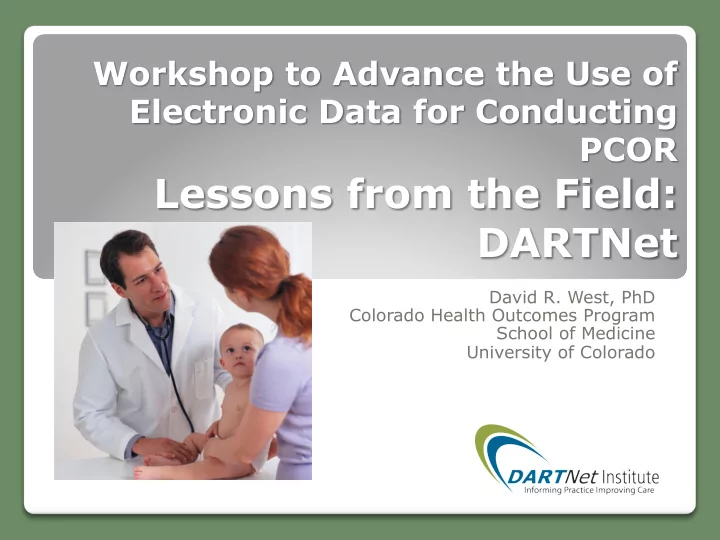

Workshop to Advance the Use of Electronic Data for Conducting PCOR Lessons from the Field: DARTNet David R. West, PhD Colorado Health Outcomes Program School of Medicine University of Colorado
Thanks and acknowledgements to: § Wilson D. Pace, MD CEO, DARTNet Institute § Lisa Schilling, MD PI, SAFTINet University of Colorado § Michael Kahn, MD, PhD Director, Biomedical Informatics Core, Colorado Clinical Translation Science Institute
DISCLOSURE STATEMENT § I have no financial investments in and receive no funding from any of the companies mentioned in this presentation. § No off label medication use will be discussed. § I have made many mistakes in my professional career, and expect to continue doing so.
Distributed Ambulatory Research in Therapeutics Network (DARTNet)
Why DARTNet? § Concept developed by Wilson Pace at the University of Colorado, as a mechanism to leverage commercially available clinical decision support technology to meet the needs of primary care clinicians and researchers § An outgrowth of the Primary Care Practice-Based Research Movement - to link physician practices together to provide them with the tools for improving quality and performance, independent of integrated healthcare systems or third party payers § To create linked clinical data to provide an improved/ enriched data source for Comparative Effectiveness Research (both observational and prospective)
What is DARTNet? § A Federated Network – Launched with support from AHRQ as a prototype to extract and capture, link, codify, and standardize electronic health record (EHR) data from multiple organizations and practices § Now a Research Institute (a not-for-profit corporation) that “houses” a Public/private partnership including: 9 research networks,12 academic partners, American Academy of Family Physicians, QED Clinical, Inc., and ABC – Crimson Care Registry § A Learning Community
DARTNet Institute eNQUIRENet CCRN CCPC FREENet MSAFPRN SAFTINet * STARNet UNYNet WPRN *Technical Partner
DARTNet Governance Legal Practical A not-for-profit BOD with Committee • corporation structure for decision- making § Participant model rather Speed boat rather than oil than membership model tanker § Ability to independently contract and secure Customer service driven grants Learning/Translation focus § Ability to charge Centralized Expertise/ indirects to cover Support: BA, DUA, LDS, PHI infrastructure needs protection, IRB, HIPAA, Security, Intellectual Property, Master Collaborative Agreements
DARTNet Scope and Scale • EHR’s = 15 Organizations ~ 85 • States = 25 Practices = >400 Clinicians linicians > 3000 3000 • Male 42% • Female 58% • 0-17 12% Patients ~ 5 million • 18-24 7% • 25-64 63% • 65-older 18%
How does DARTNet work? Step 1 Federated EHR Data Step 2 Clinical Quality Improvement Step 3 Comparative Effectiveness Research
Data management overview § Data stays locally § Standardized locally with retention of original format for both: o Quality checks o Recoding in future § Each organization retains control of patient level data § Local processing allows expansion and scale up
Technical overview § EHR independent § Data standardization middle layer tied to clinical decision support at most sites § Exploring alternative data collection approaches § Adding multiple data sources
Single Practice Perspective i Translation interface DARTNet Claims Rx CDR Web services Hospital GRID DB Queries and Data Transfers � Lab EHR Quality improvement Reports Disease registries Clinical tools
Technical Advancement : SAFTINet AHRQ R01 HS019908-01 (Lisa Schilling- PI) § New Grid Services o Based on TRIAD o Underlying database extension of OMOP o Provider, visit, claims extensions § Data moving to OMOP terminology § Adding clear text and privacy protected record linkages for 3 rd party data § Incorporation of Patient Reported Outcomes § Focus upon the underserved
Introducing ROSITA R eusable O MOP and S AFTINet I n t erface A daptor ..and ROSITA it the only bilingual Muppet
Why ROSITA? Converts/Translates EHR data into research limited data set 1. Replaces local codes with standardized codes 2. Replaces direct identifiers with random identifiers 3. Supports clear-text and encrypted record linkage 4. Provides data quality metrics 5. Pushes data sets to grid node for distributed queries
ROSITA-GRID-PORTAL
Key Achievements § Successful completion of pragmatic trails § Successful completion of observational studies § Numerous publications and monographs § Successful funding record from AHRQ, NIH, others…Spawned SAFTINet (ROSITA) § Practices achieved significant performance improvement (with tangible returns via PQRS, MOC IV, and Meaningful Use)
Opportunities/Gaps/Needs § Unlimited scale-up potential § GRID Computing Technology is not yet mature – but holds tremendous promise § Enhancing Technology and Culture to collect Patient Reported Outcomes: A research terms that encompasses so much § Testing, using, sharing ROSITA – an important contribution § Sorting out linkage to Medicaid data
Recommend
More recommend